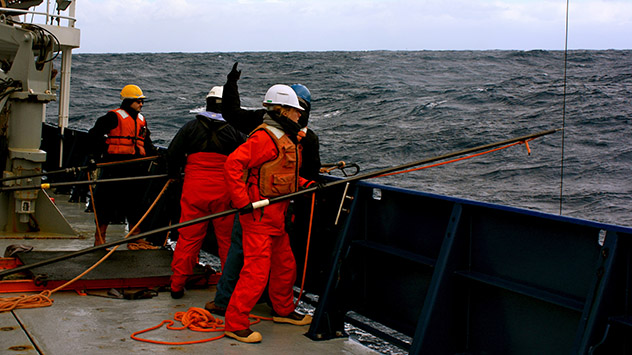Tiny Algae, Surprising Findings

On board the research vessel Roger Revelle in 2012, BIOS researcher Becky Garley helped to bring onboard a CTD instrument (used to collect measurements of seawater temperature and conductivity, a measure of salinity, at various depths). Garley helped collect data in the Southern Ocean used by researcher Nick Bates back at BIOS labs for their carbon dioxide research. She arrived at BIOS as an intern in 2010 after earning undergraduate and graduate degrees from universities in Britain. Photo by Rebecca Fowler.
Chemical oceanographer Nick Bates’s ongoing study of the ocean-atmosphere interface sheds light on a group of tiny, beautiful marine plants called coccolithophores, which have been found to release carbon dioxide into the atmosphere in regions near Antarctica.
A paper published in January in Earth & Space Science News reported that coccolithophores show a net release of carbon dioxide into seawater during plant growth as they produce minuscule structures of calcium carbonate. This differs from another common phytoplankton group in the Southern Ocean, called diatoms, that act as carbon dioxide sinks, or reservoirs, during photosynthesis.
Bates and fellow scientists found that this balance in the release of carbon dioxide seems to shift at high coccolithophore concentrations, when sufficient carbon dioxide gas builds up then escapes into the atmosphere.

Coccolithophore image by NOAA-Pacific Marine Environment Laboratory.
The start of the research was a 2008 project that looked at coccolithophores around the Falkland Islands in the South Atlantic. In subsequent years, their work grew to include the study of a phenomenon in the Southern Ocean known as the Great Calcite Belt, which appears in satellite images as an enormous band of milky water surrounding Antarctica. Coocolithophores, sphere-shaped algae covered in plates of the mineral calcite, bloom in this region near the sea surface in austral summertime.
“We found really interesting scientific issues with the coccolithophores in the Great Calcite Belt, including the issue of this bloom producing carbon dioxide,” Bates said. He was surprised to find that, in places, this actually reversed the direction of air-sea carbon dioxide exchange, turning parts of the Southern Ocean into sources of carbon dioxide flowing into the atmosphere, rather than the large carbon dioxide sink that is usually observed across the Southern Ocean.
Bates said he hopes the findings will lead to other work in the Southern Ocean. Colleagues on the project included BIOS research specialist Becky Garley; marine chemist Phoebe Lam of Woods Hole Oceanographic Institution; and the project’s principal investigator, biological oceanographer Barney Balch, and oceanographer Ben Twining, both at the Bigelow Laboratory for Ocean Sciences in Maine.
